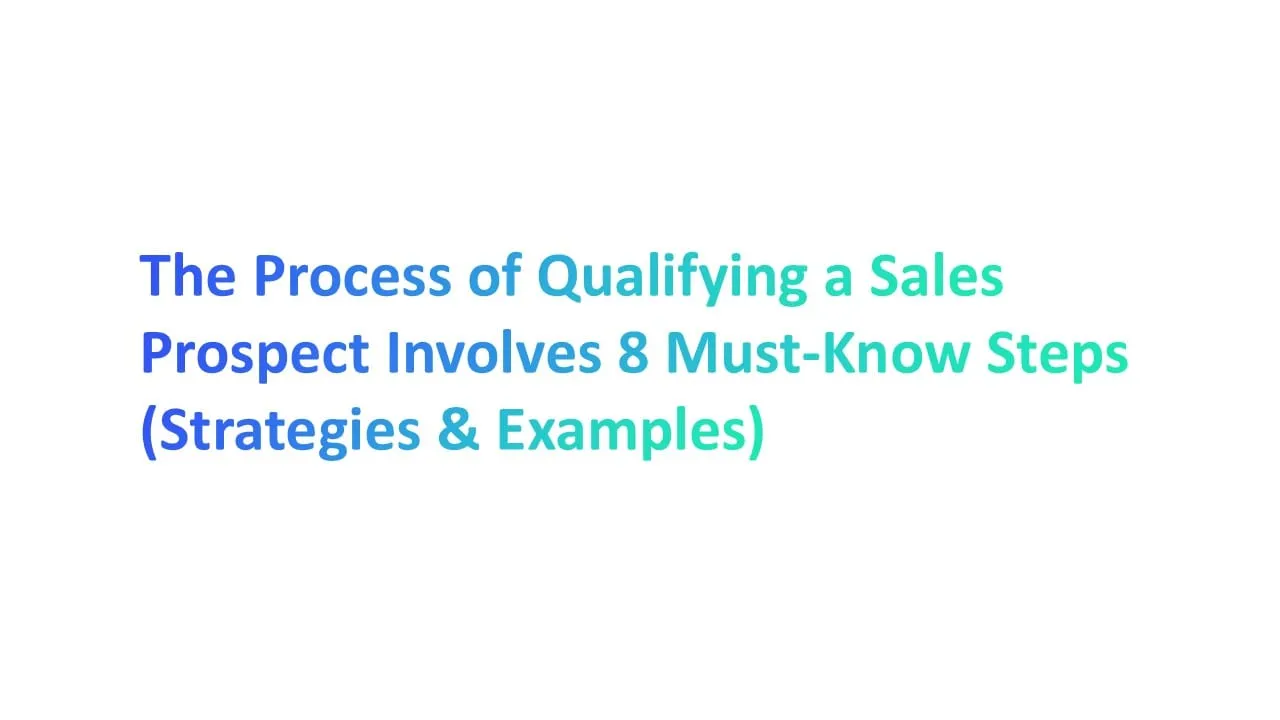Recent studies show that companies using email automation see a 14.5% increase in sales productivity and reduce marketing costs by 12.2% (Source: Nucleus Research).
Whether you're aiming to personalize messages or optimize your email campaigns for higher ROI, this guide has you covered.
What is Email Automation?

Email automation is a process that lets you send emails automatically to people based on their actions. For example, when someone signs up on a website, they might get a welcome email right away.
This tool is helpful for both big and small businesses. It saves time, helps keep new and existing customers engaged, and improves customer retention by sending personalized messages without needing manual effort.
Key Benefits of Using Email Automation

1. Personalization at Scale
With email automation, businesses can personalize messages to make customers feel special, without needing to manually send each email.
Why It Matters:
Personalized emails improve engagement. In fact, companies that use more personalized email messaging report a 20% increase in click-through rates (Source: Campaign Monitor).
For example:
- Use a customer’s name or reference past purchases, making them feel valued.
- Send personalized messages at key moments, like birthdays or sign-ups, to build a connection.
"Personalize Like Never Before - Try Alore’s Customizable Drip Campaigns!"
2. Consistent Customer Experience
Automated email campaigns ensure your customers get helpful information consistently, no matter when they join your list.
Here’s how it works:
- Automatically send welcome emails to new subscribers or customers to start their journey on a positive note.
- Triggered emails, such as reminder emails for abandoned carts, keep customers engaged without manual effort.
How It Helps:
Consistency in communication creates trust. When customers receive reliable, timely messages, they feel more comfortable with your brand and are more likely to make purchases.
3. Enhanced Customer Retention
Customer retention means keeping existing customers engaged and coming back. With automation workflows, businesses can reach out to inactive customers with re-engagement campaigns or special offers:
- Send re-engagement emails to customers who haven’t interacted in a while.
- Create anniversary emails or offer discounts to show appreciation for long-time customers.
Keeping existing customers is often more cost-effective than acquiring new ones, and email automation makes this easier.
4. Effective Re-Engagement Campaigns
Re-engagement campaigns reach out to customers who haven’t interacted with your business for a while.
Why It Works:
Re-engagement campaigns can increase customer retention by up to 30% (Source: Invesp). By using automated email tools, you ensure that each customer gets the right message at the right time, without any manual effort.
Here’s how email automation helps:
- Triggered Emails: Automated email campaigns let you send reminders, special offers, or re-engagement emails to bring customers back.
- Win Back Interest: If a customer hasn’t opened your emails in a few months, a friendly reminder email with a discount code can catch their attention.
5. Cross-Selling and Upselling Opportunities
Email automation makes it easy to suggest additional products or upgrades, known as cross-selling and upselling. This approach helps grow the sales funnel for your business and makes each email more valuable.
Why It’s Useful:
Companies using personalized messaging in their email marketing see higher click-through rates. This means customers are more likely to view and consider the recommended products.
How to do it:
- Cross-Sell Products: If a customer recently purchased a phone, suggest related items like headphones or a phone case in a follow-up email.
- Upsell to Higher Options: If they bought a basic service package, you can send an automated email offering an upgrade to a premium package.
6. Data-Driven Insights
Email automation software provides data on how your emails perform, helping you improve over time. Here’s what you can track:
- Click-Through Rates (CTR): Shows how many people clicked on links within your emails, giving you insight into what interests them.
- Customer Journey: Follow how a customer interacts with each email and tailor future emails accordingly.
How It Helps:
With data-driven insights, you can send emails that better match your customer’s interests. For example, if you see that “welcome emails” have a high CTR, you might send more personalized messages early in the customer journey.
Using email automation tools, you can access these metrics easily and adjust your email marketing strategy based on real numbers.
"See Your Open Rates Soar with Alore’s Blaze Warmer!"
How does Email Marketing Automation Work?
1. Define Your Objectives
Before you start, think about what you want to achieve with email automation. Do you want to welcome new subscribers, improve customer retention, or encourage repeat purchases?
Why It’s Important:
Defining objectives helps you focus on the right messages. When each email campaign has a clear goal, you can measure success more easily.
How to Implement:
- Write down specific goals. For instance, if your goal is to welcome new subscribers, your objective could be to increase click-through rates on the welcome email by 20%.
- Setting clear objectives ensures that each automated email campaign has a purpose and that you’re sending the right message at the right time.
2. Segment Your Audience
Audience segmentation means dividing your email subscribers into groups based on things like age, purchase history, or interests.
Why It’s Important:
When you segment subscribers, they receive personalized emails, which makes them feel valued. For example, existing customers can receive exclusive updates or targeted messages, while new customers get introductory information.
How to Implement:
- Use an email automation tool to create different lists for each segment.
- You could have one list for new subscribers and another for loyal customers.
- Always keep the customer’s needs in mind. Send emails that match their stage in the customer journey, such as welcome emails for new subscribers and re-engagement campaigns for those who haven’t interacted in a while.
Segmenting your audience is a key part of marketing automation. It ensures that customers receive emails they’re genuinely interested in.
3. Map the Customer Journey
Mapping the customer journey means planning out the steps a customer might take with your business, from discovering your product to becoming a loyal customer.
Why It’s Important:
Understanding the customer journey allows you to send emails that match where a person is in their journey.
For example, if someone has shown interest in a product but hasn’t purchased it, an automated follow-up email with a discount code can encourage them to complete the purchase.
How to Implement:
- Create a visual map of your customer journey.
- Mark points where automated emails could help, such as a reminder email for abandoned carts or an anniversary email for loyal customers.
4. Select an Email Automation Platform
To start with email automation, you need a reliable email automation platform. This software is where you’ll create, schedule, and send automated emails. For small businesses, even a simple Gmail account can be integrated with some email automation tools to start automating emails.
Why It’s Important:
Choosing the right email automations tool makes it easier to organize campaigns and track your email marketing efforts.
A good platform will allow you to send emails to new subscribers, create targeted messages, and monitor click-through rates.
How to Implement:
- Look for features like customizable email templates, audience segmentation, and click-through tracking.
- You might want to try a free trial of several tools to find the one that best fits your needs.
Picking the right platform is like choosing the base for your email marketing automation strategy. It keeps everything in one place and helps manage all your campaigns smoothly.
5. Create Engaging Content
Content is the heart of every email marketing campaign. Without engaging content, automated emails won’t grab attention or build connections.
Why It’s Important:
With engaging, personalized emails, you can keep existing customers interested and attract new leads to grow your business.
How to Implement:
- Start with Strong Subject Lines: Subject lines should be clear and to the point. For example, “Welcome to Our Community!” can make new customers feel appreciated.
- Use Personalized Messaging: Address your subscribers by name and include dynamic content that fits their interests or past purchases.
- Think about what your audience cares about. Use automation software to add personal touches, like mentioning past purchases or offering discounts for new subscribers.
6. Set Up Automation Workflows
Automation workflows let you schedule emails to send based on certain actions, like signing up or making a purchase. This keeps communication consistent without manual effort.
They automatically send emails when certain conditions are met. For example, you can send a welcome email as soon as someone joins your list or a reminder email if they leave items in their online shopping cart.
Why It’s Important:
Workflows save you time and help maintain a consistent customer experience. You can focus on creating great content while your email automation tools handle the timing and delivery.
How to Implement:
- Start simple. Set up a welcome email workflow for new subscribers, then add more workflows over time.
- Many email automation tools come with ready-made workflows that are easy to customize.
7. Test and Optimize
Testing and optimizing are key steps in making email marketing automation effective. Testing allows you to see what works best in your automated email campaigns. You can test subject lines, email design, and even the timing of your messages.
Why It’s Important:
Testing helps you understand what your audience likes and what drives engagement. Data-driven adjustments can improve your click-through rates and customer retention.
How to Implement:
- Start with A/B testing, where you send two versions of an email to see which one performs better.
- Use insights from tests to make changes and optimize your content. This way, each email automation campaign becomes smarter and more successful over time.
"Track Every Email Like a Pro! Discover Alore’s Analytics Dashboard!"
Best Practices for Effective Email Marketing Automation
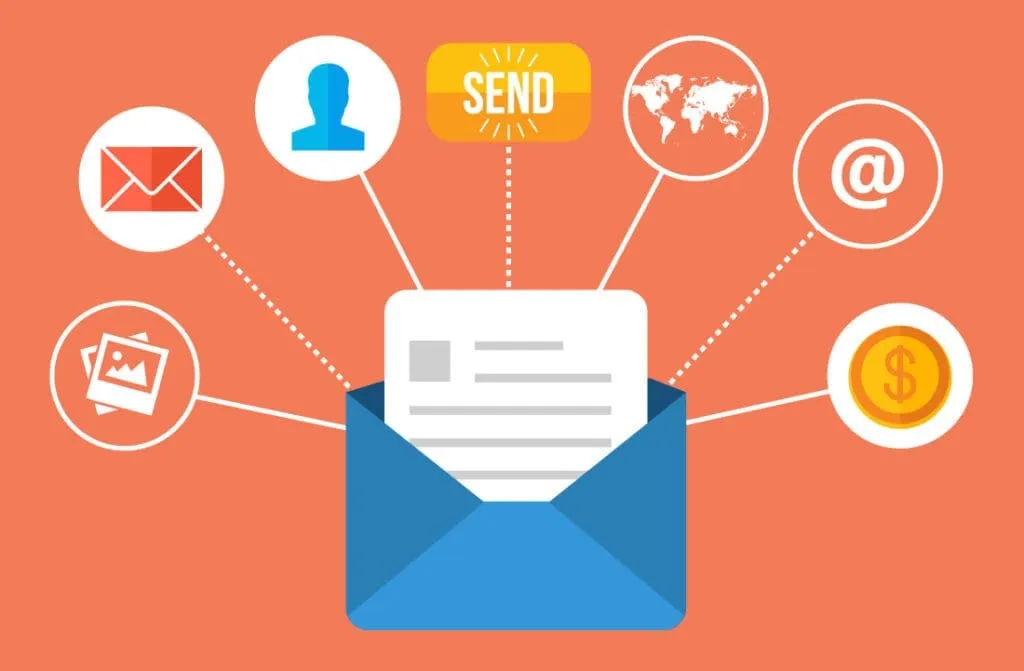
1. Define Clear Goals for Each Campaign
To begin, set a clear goal for marketing purposes with each email campaign. Ask yourself: What do you want to achieve with this campaign? You might aim to welcome new subscribers, re-engage inactive users, or drive customer retention by encouraging existing customers to make repeat purchases.
Clear goals help you create targeted messages that fit each subscriber’s journey. When you know your goal, you can measure the success of your email automation efforts more effectively.
For each campaign, write down specific objectives. For example, if you’re running a welcome email campaign, set a goal to increase new subscribers' engagement by 20%.
"Ready to Simplify Your Campaign Management? Try Alore Today!"
2. Automate Based on Behavior Triggers
Behavior triggers allow you to send automated emails based on specific actions taken by your subscribers.
Triggers are actions that subscribers take, like clicking a link, making a purchase, or signing up. For example, if a user adds an item to their cart but doesn’t check out, a triggered reminder email can prompt them to complete the purchase.
Automating emails based on behavior creates a more personalized experience. Studies show that personalized messaging can improve engagement rates and drive conversions.
Use your email automation tools to set up triggers. Examples of triggered email might include sending a welcome email to new subscribers, follow-up emails for past purchases, or reminder emails for abandoned carts.
3. Optimize Subject Lines for Every Audience
Your email’s subject line is often the first thing a subscriber sees, so make it count! A great subject line grabs attention and encourages subscribers to open the email. Optimized subject lines can significantly increase your open rates and click-through rates.
Keep your subject lines clear, personal, and relevant to the target audience. Use A/B testing to find out which subject lines work best for each campaign. Try using numbers, questions, or even emojis to make your emails stand out in crowded inboxes.
Personalize the subject line of blog post to include the subscriber's name, or refer to something they recently interacted with on your site.
4. Set Up A/B Testing for Continuous Improvement
A/B testing allows you to test two versions of an email to see which one performs better.
A/B testing helps you understand what your audience likes best. You can improve open rates, click-through rates, and customer retention by testing different subject lines, images, or calls to action.
Try testing one variable at a time, such as the email’s subject line or content. Use your email automation tools to measure which version leads to more engagement. Running A/B tests regularly helps you continuously improve your email marketing automation.
5. Time Emails Based on User Activity
Sending emails at the right time can make a big difference in engagement. Timing emails based on user activity ensures that your messages reach subscribers when they’re most likely to open them. Studies show that well-timed emails can enhance engagement and click-through rates.
Use automation workflows to send automatic emails, triggered by user actions, like signing up or making a purchase. Analyze your audience’s habits to find the best times for sending automated emails, whether it’s in the morning or evening.
Timing emails based on activity helps ensure you’re connecting with your audience when it matters most.
6. Implement Win-Back Campaigns for Inactive Users
Win-back campaigns are designed to re-engage subscribers who haven’t interacted with your emails in a while. These campaigns can help you reconnect with users who might otherwise unsubscribe. Win-back campaigns remind inactive subscribers of your brand and offer incentives to bring them back.
Set up automated email campaigns specifically for inactive users, using email marketing automation tools. Offer incentives, like a discount code or special content, to encourage engagement.
Win-back campaigns help you maintain your subscriber base by reaching out to those who need a little extra motivation to re-engage.
"Stay on Top of Every Interaction! Explore Alore’s Reply Handling Now!"
7. Use a Clear Call to Action (CTA)
A call to action (CTA) tells your readers what to do next, whether it's to click a link, download something, or sign up.
A clear CTA guides your audience, making it easy for them to respond to your message. Well-placed CTAs can increase click-through rates and drive more engagement.
Use simple, action-focused language like “Download Now” or “Get Your Discount.” Place your CTA button where it’s easy to see, like near the top or at the end of your email. A strong CTA encourages readers to take the next step, boosting engagement and conversions.
8. Incorporate Dynamic Content Blocks
Dynamic content adjusts based on the reader’s interests or behaviors, making emails feel more personal. Personalized messages increase open rates and engagement. Dynamic content allows you to show each reader the most relevant information, like products they viewed or special offers for them.
Many email automation tools let you create dynamic blocks within your emails. Set these blocks to change based on user data, such as past purchases or browsing history. With dynamic content, your emails become more meaningful to each reader, enhancing customer retention and response.
9. Use Analytics to Measure ROI
Analytics help you understand if your email campaigns are working. Tracking return on investment (ROI) can show which strategies bring the best results.
Measuring success with data lets you see what’s working and what isn’t. This insight allows you to adjust your email marketing strategy and make informed improvements.
Use email automation software to track metrics like open rates, click-through rates, and conversions. Compare the costs of your campaigns with the revenue generated to calculate ROI. Using analytics helps you make data-driven decisions and continuously improve your email marketing efforts.
10. Utilize Multi-Channel Integrations
Integrating email marketing with other channels like social media, SMS, and websites can improve your reach. Multi-channel integration helps you deliver automated emails alongside targeted messages on different platforms.
For example, after manually sending a welcome email, you can automatically send reminders via SMS or social media. Using multi-channel strategies ensures your messages reach customers through their preferred channels.
"Scale Effortlessly! Alore’s Auto-Rotation and Multi-Account Integration Awaits!"
Top Email Automation Tools
1. Alore
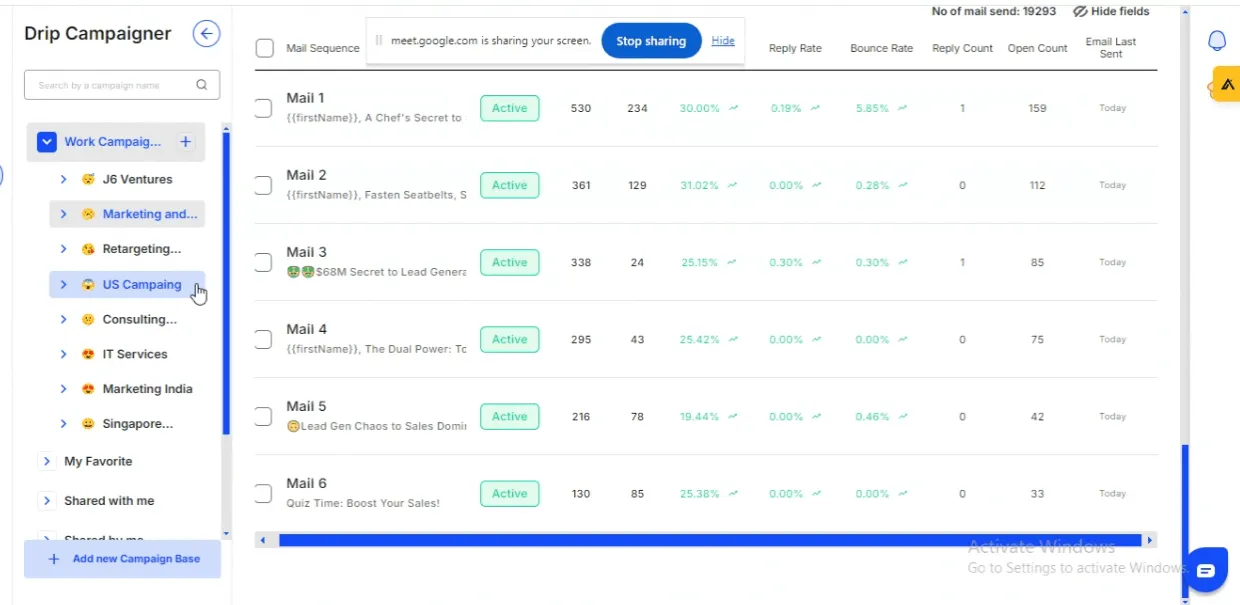
Alore is an advanced email automation tool designed for businesses of all sizes. It helps businesses manage campaigns, warm up email domains, and improve deliverability
Key Features:
- Campaign Management: Alore allows users to organize multiple campaigns within categories like "Marketing," "Consulting," and "IT Services." This helps keep campaigns organized and targeted.
- Drip Campaigner: You can set up drip campaigns with customizable mail sequences, including personalization (e.g., {{firstName}}), to create a personal connection with recipients.
- Analytics Dashboard: The dashboard provides essential metrics such as open rates, reply rates, and click-through rates. Users can monitor these for continuous optimization.
- Email Warm-Up: Alore has email warm-up capabilities to improve domain health and email deliverability. It monitors open rates, reply rates, and spam protection metrics.
- Automation Workflows: Set up workflows that include automation options like mail integration, weekday-only sending, and mail rotation for balanced volume.
- Integration and Security: Supports database integration and complies with security standards, ensuring data protection and adherence to privacy policies.
How to Use:
- Set Up Campaigns: Start by organizing your campaigns based on specific goals or target audiences.
- Design Drip Sequences: Customize your emails and add placeholders for personalization.
- Monitor Performance: Use the analytics dashboard to view open rates and engagement stats.
- Warm-Up Emails: Gradually increase email sending volumes with Alore’s warm-up settings to protect deliverability.
Pricing: Alore offers various pricing plans tailored to different business needs. Pricing details may vary, so it's recommended to check the pricing page on their website for the latest information.
- Pros: Detailed analytics, easy navigation, customizable sequences, and integration with multiple email accounts.
- Cons: Limited customization options for smaller campaigns.
2. Klaviyo
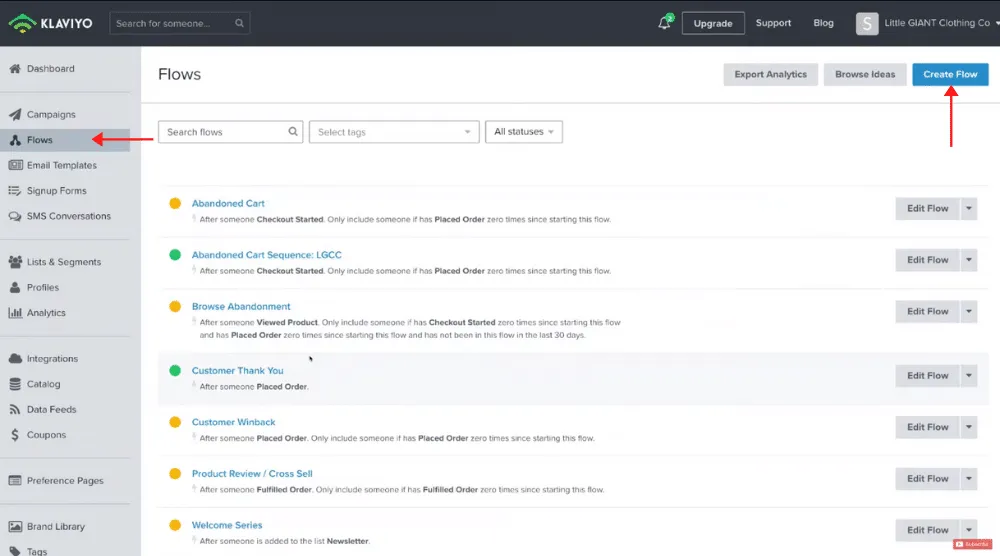
Klaviyo is an email marketing automation platform popular for its data-driven approach, especially among e-commerce businesses. It allows companies to send personalized messages based on customer actions.
Key Features:
- Behavioral Triggers: Klaviyo lets you automate emails based on customer actions, such as purchases or browsing history.
- Segmentation: Segment your audience based on specific behaviors, enabling targeted email campaigns.
- Data Analytics: Klaviyo provides in-depth analytics, tracking open rates, click-through rates, and more to measure the effectiveness of each campaign.
- Multi-Channel Marketing: Besides emails, Klaviyo integrates SMS marketing, offering a comprehensive solution for customer engagement.
How to Use: Set up a campaign by selecting a trigger (like a product purchase) and customizing the email sequence. Klaviyo’s segmentation lets you target specific audience groups, helping you create more relevant marketing messages too.
Pricing: Klaviyo offers flexible pricing based on the number of contacts in your list, with options to add SMS as an additional service.
- Pros: Strong segmentation options, robust analytics, and multi-channel integration.
- Cons: Pricing may be higher for businesses with large contact lists.
3. Omnisend
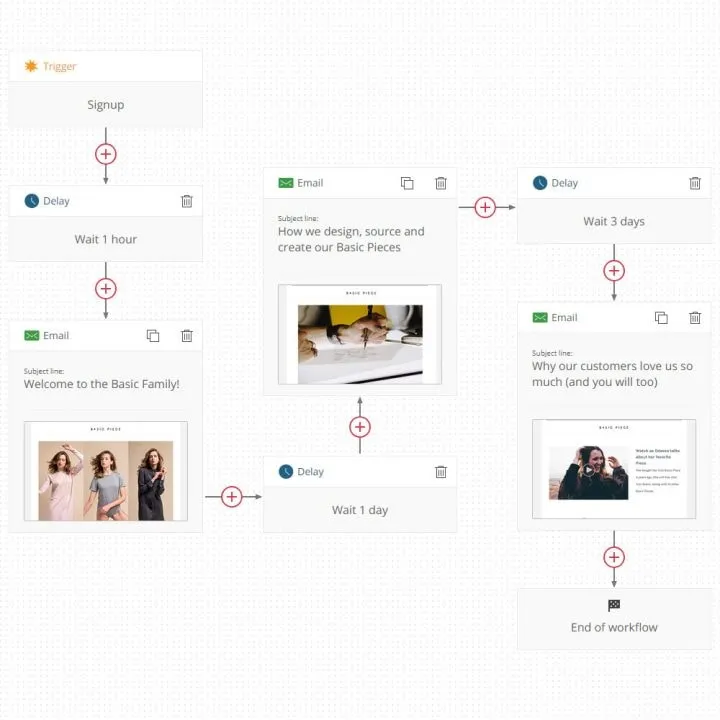
Omnisend is a versatile email marketing automation tool. It’s especially popular among ecommerce businesses. This platform focuses on helping users send targeted messages to engage customers and increase sales.
Key Features:
- Pre-built Automation Workflows: Omnisend includes workflows for actions like welcome emails, cart recovery, and order confirmations.
- Multi-Channel Support: In addition to email, you can reach customers through SMS, push notifications, and more.
- Audience Segmentation: Helps you segment subscribers for highly targeted email campaigns.
- Dynamic Content Blocks: Allows for personalized emails that make customers feel valued.
- Email Automation Templates: Easy-to-use templates make email design simple, even for beginners.
How to Use:
- Set Up Account: Create an account and link your online store if you have one.
- Choose an Automation Workflow: Start with a basic workflow, like welcome email automation.
- Customize Your Content: Adjust the message and design to fit your brand.
- Monitor and Optimize: Use Omnisend’s analytics to track performance and make improvements.
Pricing: Omnisend has a free plan, ideal for small businesses or those new to email automation. Paid plans start around $16 per month, offering advanced features like SMS and push notifications.
G2 Rating: Omnisend has an average rating of 4.5 out of 5 on G2, based on user feedback.
- Pros: Easy integration with e-commerce platforms, multi-channel support, and effective automation workflows.
- Cons: Some users report limited customization in templates, and SMS costs may add up.
4. ActiveCampaign
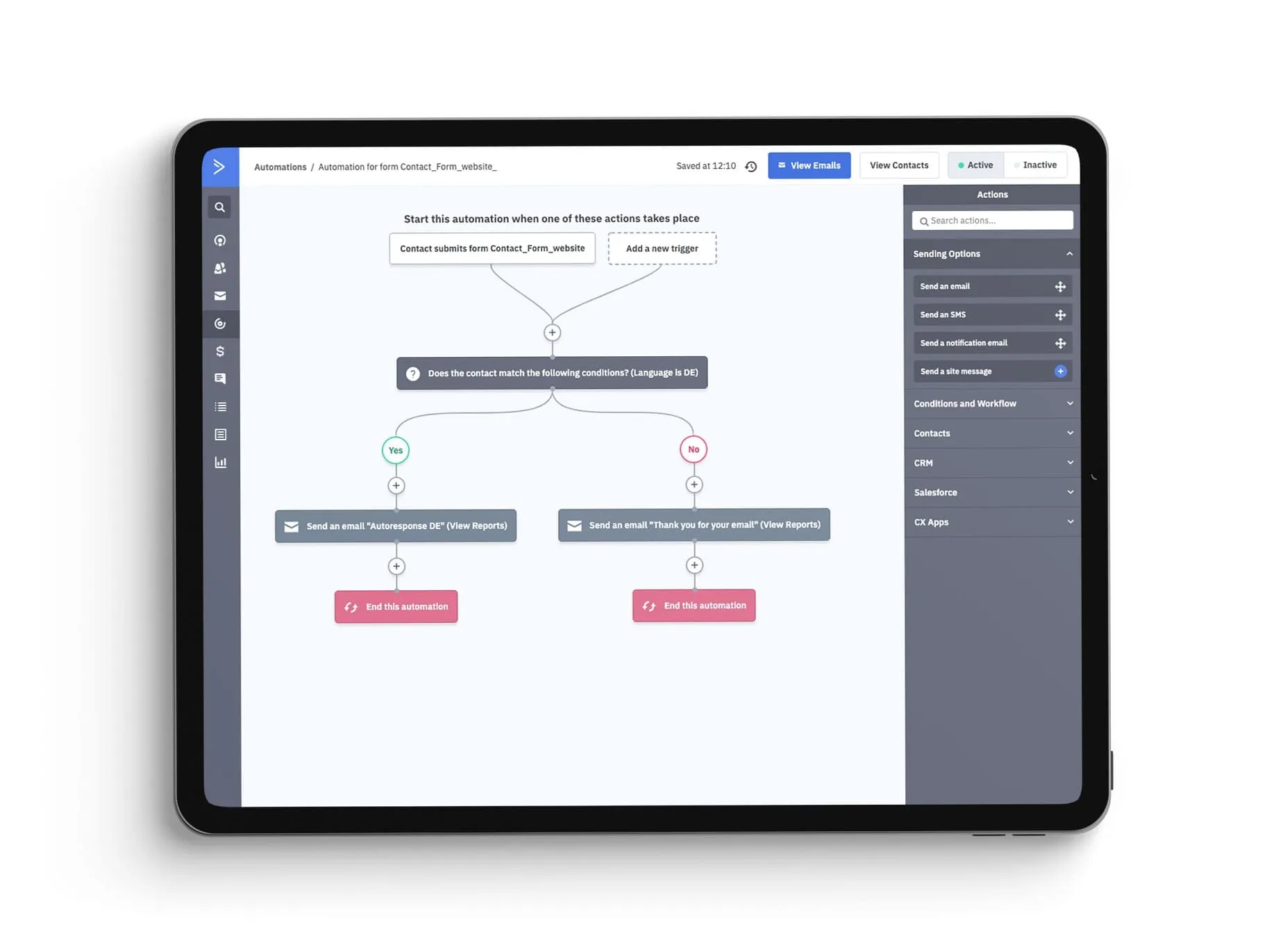
ActiveCampaign is an advanced email automation tool that combines email marketing automation with CRM (Customer Relationship Management) features. This makes it an excellent choice for businesses looking to improve both customer retention and marketing efforts.
Key Features:
- Advanced Automation Workflows: Offers customizable workflows for almost any customer interaction, from welcome emails to complex re-engagement campaigns.
- Behavioral Triggers: Sends emails based on customer actions, like clicking a link or visiting a page.
- CRM Integration: Syncs customer interactions with sales, making it easy to track each subscriber's journey.
- Automation Workflows: Simplifies campaign setup by offering pre-made templates for various types of automated email campaigns.
- Personalized Messaging: Includes tools for crafting emails tailored to specific customer needs.
How to Use:
- Account Setup: Sign up and connect with your existing email subscribers.
- Set Goals: Define your objectives, like increasing click-through rates or new customer acquisition.
- Create an Automation Workflow: Choose triggers based on customer behaviors to automate engagement.
- Analyze Results: Use detailed analytics to monitor open rates, click-through rates, and customer engagement.
Pricing: ActiveCampaign offers a free trial, with plans starting at $15 per month, depending on the features and subscriber count.
G2 Rating: ActiveCampaign holds a 4.6 out of 5-star rating on G2, reflecting positive feedback from users.
- Pros: Strong CRM integration, flexible automation, and powerful behavioral triggers.
- Cons: Higher learning curve for beginners, and the pricing can increase quickly as your contact list grows.
5. Brevo (formerly SendinBlue)

Brevo is an email automation tool designed to help businesses easily create and send email marketing campaigns.
Originally known as SendinBlue, it was rebranded as Brevo, but its goal remains the same: to provide affordable and reliable email marketing software and services for all business sizes, especially small businesses.
Key Features:
- Easy-to-Use Email Builder: Brevo has a simple drag-and-drop editor. You can design emails without needing any coding skills.
- Automation Workflows: It allows setting up automated email workflows to send targeted messages based on user actions, such as welcome emails for new subscribers or reminder emails for abandoned carts.
- SMS Campaigns: Besides email, Brevo offers SMS marketing to reach audiences on multiple channels.
- Segmentation: You can segment subscribers into different groups based on their behavior and interests.
- Dynamic Content: Include personalized messaging in your emails based on user data to improve customer engagement.
How to Use:
- Sign Up and Set Goals: Create a Brevo account and decide what you want to achieve with your email campaigns, such as gaining new subscribers or improving customer retention.
- Build Your Emails: Use the drag-and-drop builder to create your first email or use one of Brevo’s templates.
- Set Up Automations: Go to the automation tool section to set up workflows, such as sending welcome emails to new subscribers.
- Send and Track: After setting everything up, launch your campaign and monitor performance through the analytics dashboard.
Pricing:
- Brevo offers a free plan, allowing up to 300 emails per day.
- Paid plans start at around $25 per month, with options for businesses that need advanced features.
G2 Rating: Brevo has a G2 rating of 4.3, based on ease of use and reliable customer support.
- Pros: Simple interface, affordable plans, includes SMS marketing.
- Cons: Limited features in the free plan, customer support response time can vary.
6. HubSpot

HubSpot is a comprehensive marketing, sales, and customer service platform. It’s known for its advanced email marketing automation, CRM (customer relationship management), and a wide range of additional marketing tools, making it ideal for companies wanting more than just email automation.
Key Features:
- Email Automation: HubSpot’s email automation is highly customizable. You can set up workflows that respond to user actions, such as clicking on an email link or viewing a product.
- Customer Retention Tools: With its CRM integration, HubSpot helps keep track of customer interactions, enhancing customer retention efforts.
- Lead Scoring and Segmentation: You can segment customers and assign scores based on their engagement level, helping you target those most likely to convert.
- Analytics and Reports: HubSpot offers detailed analytics on click-through rates, email deliverability, and other key metrics.
- Landing Pages and Forms: Use HubSpot to create landing pages and forms to capture new leads, which then enter your email workflows automatically.
How to Use:
- Create an Account and Set Goals: Sign up for HubSpot and outline your main objectives, like increasing new leads or setting up re-engagement campaigns.
- Build Email Campaigns: Create emails using HubSpot’s editor, adding dynamic content for personalized messaging.
- Set Up Automations: Use the workflow tool to send automated email campaigns, like drip campaigns, based on customer interactions.
- Analyze Results: After sending emails, review the reports to see click-through rates and other metrics, helping you refine future emails.
Pricing: HubSpot’s basic email marketing plan starts free, but its full Marketing Hub plan with advanced features begins at around $50 per month.
G2 Rating: HubSpot has a strong G2 rating of 4.4, with users appreciating its full suite of tools and support.
- Pros: All-in-one platform, advanced CRM features, robust automation tools.
- Cons: Higher cost for advanced plans, learning curve due to extensive features.
7. Mailchimp
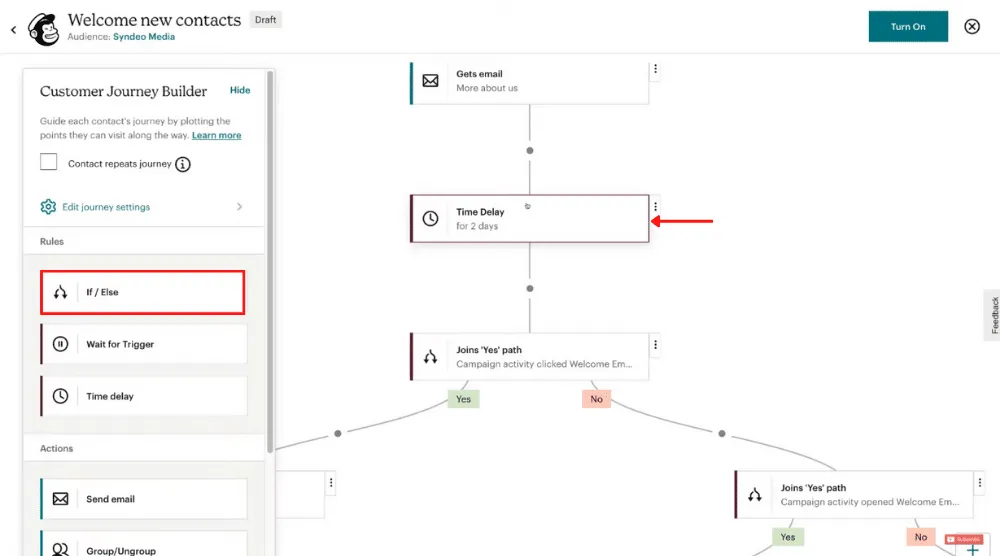
Mailchimp is a popular email automation tool. It helps businesses send automated email campaigns to their subscribers. It’s known for its user-friendly design, making it easy for beginners to use.
Key Features:
- Drag-and-Drop Builder: Easily create email campaigns without needing coding skills.
- Audience Segmentation: Organize and target specific groups within your subscriber list.
- Pre-designed Templates: Use customizable templates to save time on email creation.
- Analytics and Reporting: Track the performance of your email marketing campaigns.
How to Use: Start by setting up an account on Mailchimp. Create a list of subscribers, design your email with the drag-and-drop tool, and choose your audience. Mailchimp can automatically send emails based on triggers like a new subscriber joining your list or a product purchase.
Pricing: Mailchimp offers a free plan with basic features. Paid plans start at $9.99 per month and increase based on the number of subscribers and advanced features.
G2 Rating: Mailchimp holds a high rating on G2, with many users appreciating its ease of use and effectiveness in email marketing automation.
Pros:
- User-friendly interface
- Wide range of templates
- Strong analytics for tracking results
Cons:
- Limited automation in the free plan
- Costs increase as subscriber numbers grow
8 Examples of Effective Automated Email Campaigns
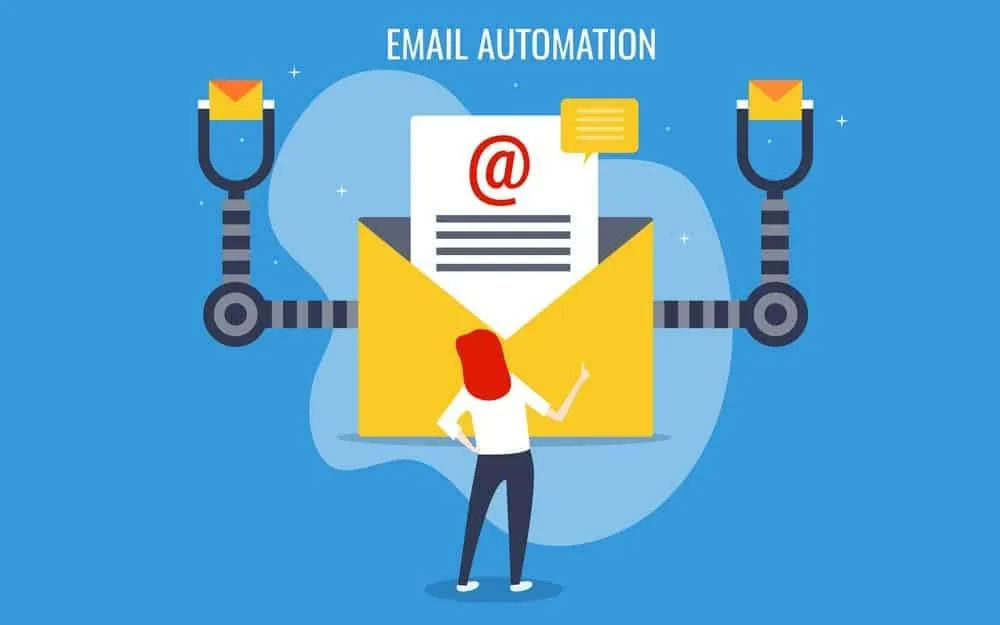
1. Welcome Series for New Subscribers
A welcome email series is the first interaction new subscribers have with your brand. It's a friendly way to say hello and introduce what you offer.
How It Works:
Once someone subscribes to your list, they receive a sequence of welcome emails. The first email might thank them for subscribing, while the second could introduce your most popular products or services. The goal of such messages is to make a great first impression.
2. Abandoned Cart Reminders
Abandoned cart emails remind customers about items they left in their online cart without checking out. These emails help recover lost sales.
How It Works:
When someone places items in their cart but doesn’t complete the purchase, the system automatically sends an abandoned cart reminder.
These reminders can include images of the products, a discount code, or a sense of urgency to encourage the purchase. It’s one of the most effective automated email campaigns for customer retention.
3. Post-Purchase Follow-Up
A post-purchase email checks in with customers after they’ve made a purchase. It’s a chance to say thanks and show them you value their business.
How It Works:
After a customer buys a product, they receive a follow-up email. This could be a thank-you message or a request for feedback.
This type of campaign builds loyalty and keeps your customers engaged. Some businesses even include a discount code to encourage repeat purchases.
4. Birthday or Anniversary Campaigns
Birthday or anniversary emails are a fun way to show customers you care. This type of email automation is a great way to make users feel valued.
It’s simple: send a special message on a birthday or other special date. Often, companies include a small gift, like a discount code, to make the email even more exciting.
How To Use It:
Set up email automation software to send birthday emails on each user’s birthday. Many email marketing tools let you automate this process by setting the date and content in advance.
5. Re-Engagement Campaign for Inactive Users
A re-engagement campaign targets users who haven’t interacted with your emails in a while. This type of automated email campaign asks if they’d like to stay subscribed or if they’d like to come back. It’s a great way to bring people back who may have forgotten about your brand.
How To Use It:
Schedule these automated emails to go out after a certain period of no activity, such as 3 or 6 months. Include a friendly message and maybe a special offer to entice the reader to interact with your brand again.
6. Product Review or Testimonial Request
Asking for feedback is a valuable step after a purchase. Automated product review or testimonial request emails make it easy to gather feedback. These emails ask customers to share their thoughts about a recent purchase.
How To Use It:
Set up email automation to send these requests a few days or weeks after a purchase. Make it simple for the customer to leave a review by including a direct link to a feedback form or review the landing page here.
7. Educational Drip Campaign for New Users
An educational drip campaign helps new users learn more about your products or services over time. This type of campaign is sent in small, easy-to-understand emails over several days or weeks.
How it works:
After a user signs up, they receive one email at a time, focusing on important topics. For example, the first email could introduce basic features, while later emails dive deeper into advanced features. By breaking information down, users learn without feeling overwhelmed.
8. Seasonal or Holiday-Themed Promotions
Seasonal promotions keep your brand fresh in the minds of your audience by celebrating specific events or holidays.
How it works:
Leading up to a holiday, you send themed emails that may include a holiday greeting, special discounts, or gift ideas. For example, an email could say, "Celebrate the holiday season with 20% off!" This grabs attention and can motivate users to act.
Conclusion
Email automation helps you stay connected with your customers and build stronger relationships. From defining each campaign’s purpose to using targeted messages, email automation can save time and improve results. By understanding email automation, you can grow your business with more effective, automated campaigns that reach the right people at the right time.

.webp)



